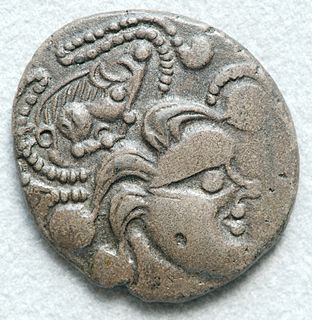Related Research Articles

The Taurini were a Celto-Ligurian tribe dwelling in the upper valley of the river Po, around present-day Turin, during the Iron Age and the Roman period.
The Viducasses were a Gallic tribe dwelling in the modern Calvados department during the Iron Age and the Roman period.

The Petrocorii were a Gallic tribe dwelling in the present-day Périgord region, between the Dordogne and Vézère rivers, during the Iron Age and the Roman period.

The Bodiocasses or Baiocasses were an ancient Gallic tribe of the Roman period. They were a tribal division of the civitas of the Lexovii, in the Roman province of Gallia Lugdunensis.
The Medulli were a Gallic tribe dwelling in the upper valley of Maurienne, around present-day Modane (Savoie), during the Iron Age and Roman period.
The Alauni were a Gallic tribe dwelling around Chiemsee (Bavaria) during the Roman period.
The Lexovii, were a Gallic tribe dwelling immediately west of the mouth of the Seine, around present-day Lisieux, during the Iron Age and the Roman period.
The Veragri were a Gallic tribe dwelling around present-day Martigny, in the Pennine Alps, during the Iron Age and the Roman period.
The Latobici or Latovici were a Celtic tribe dwelling in Pannonia Superior, around present-day Drnovo (Slovenia), during the Roman period.
The Veliocasses were a Belgic or Gallic tribe of the La Tène and Roman periods, dwelling in the south of modern Seine-Maritime and in the north of Eure.

The Vindelici were a Gallic people dwelling around present-day Augsburg (Bavaria) during the Iron Age and the Roman period.
The Vediantii were a Celto-Ligurian tribe dwelling on the Mediterranean coast, near present-day Nice, during the Iron Age and the Roman period.
The Venisami or Venisamores were a Gallic tribe dwelling in the Alps during the Iron Age.
The Ambisontes were a Gallic tribe dwelling in the upper Salzach valley during the Roman period.
The Rucinates or Rucantii were a Gallic tribe dwelling in near the confluence of the Isar and Danube rivers during the Roman period.
The Genauni or Genaunes were a Gallic tribe dwelling in the eastern valley of the Inn river, in Tyrol, during the Iron Age and the Roman period.
The Ambilici were a Gallic tribe dwelling in the valley of Gail river during the Roman period.
The Catenates or Cattenates were a Gallic tribe dwelling between the Isar and Inn rivers during the Iron Age.
The Brigantii were a Gallic tribe dwelling southeast of Lake Constance, near present-day Bregenz (Vorarlberg), during the Roman era.
The Brixentes or Brixenetes were a Gallic tribe dwelling at the confluence of the Eisack and Rienz rivers, near present-day Brixen, during the Iron Age and the Roman era.
References
- ↑ Strabo. Geōgraphiká, 4:6:8.
- 1 2 Pliny. Naturalis Historia, 3:20.
- ↑ Ptolemy. Geōgraphikḕ Hyphḗgēsis, 2:12:4.
- ↑ Falileyev 2010, s.v. Licates.
- ↑ de Bernardo Stempel 2015, pp. 89–90.
- 1 2 Dietz 2006a.
- ↑ Talbert 2000, Map 19: Raetia.
- ↑ Schumacher, Dietz & Zanier 2007.
- ↑ Dietz 2006b.
- ↑ Delamarre 2003, p. 135.
Primary sources
- Pliny (1938). Natural History. Loeb Classical Library. Translated by Rackham, H. Harvard University Press. ISBN 978-0674993648.
- Strabo (1923). Geography. Loeb Classical Library. Translated by Jones, Horace L. Harvard University Press. ISBN 978-0674990562.
Bibliography
- de Bernardo Stempel, Patrizia (2015). "Zu den keltisch benannten Stämmen im Umfeld des oberen Donauraums". In Lohner-Urban, Ute; Scherrer, Peter (eds.). Der obere Donauraum 50 v. bis 50 n. Chr. Frank & Timme. ISBN 978-3-7329-0143-2.
- Delamarre, Xavier (2003). Dictionnaire de la langue gauloise: Une approche linguistique du vieux-celtique continental. Errance. ISBN 9782877723695.
- Dietz, Karlheinz (2006a). "Licates". Brill's New Pauly. doi:10.1163/1574-9347_bnp_e704080.
- Dietz, Karlheinz (2006b). "Damasia". Brill's New Pauly. doi:10.1163/1574-9347_bnp_e310110.
- Falileyev, Alexander (2010). Dictionary of Continental Celtic Place-names: A Celtic Companion to the Barrington Atlas of the Greek and Roman World. CMCS. ISBN 978-0955718236.
- Schumacher, Stefan; Dietz, Karlheinz; Zanier, Werner (2007). "Vindeliker". In Beck, Heinrich (ed.). Reallexikon der Germanischen Altertumskunde. 35 (2 ed.). De Gruyter. ISBN 978-3110187847.
- Talbert, Richard J. A. (2000). Barrington Atlas of the Greek and Roman World. Princeton University Press. ISBN 978-0691031699.
